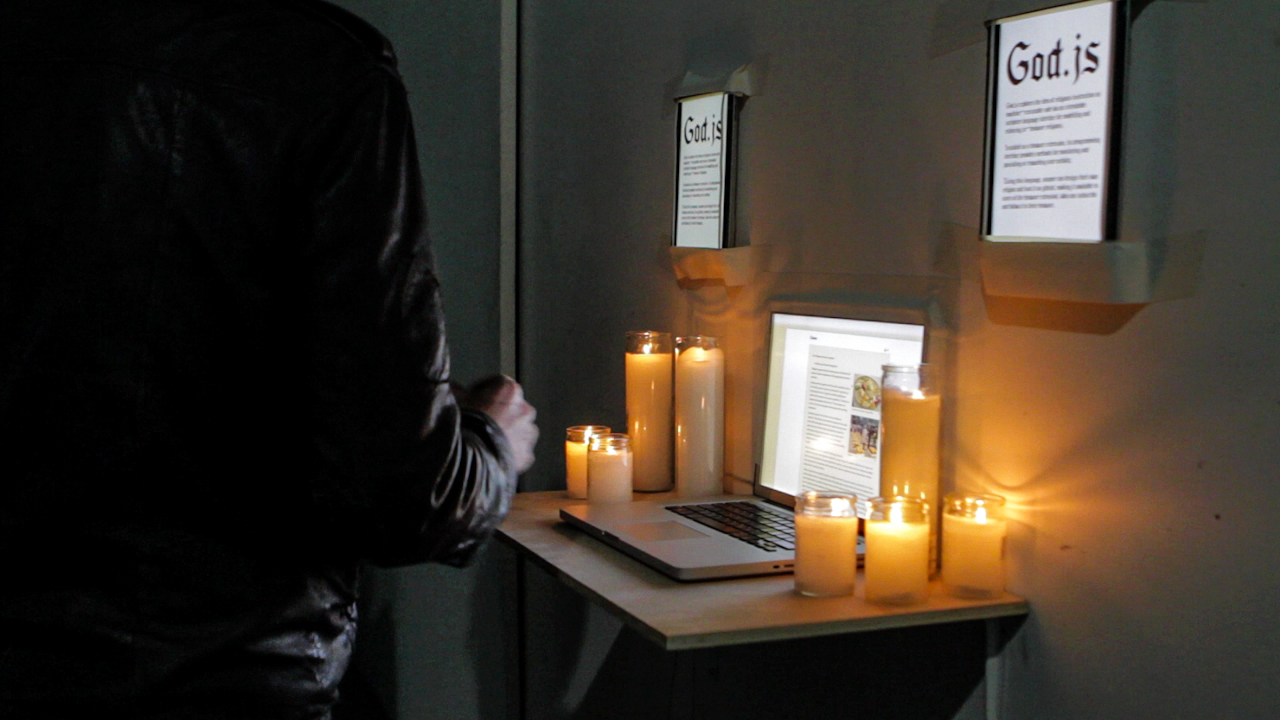“I wanted to create a game that touched infinity,” Jonathan Minard explains. We’re in the dark lower level of 319 Scholes at the opening Art Hack Day: God Mode. To his right, bio-glitch artists in lab-coats explain How to be Anonymous in the Age of the DNA Surveillance. Behind him, visitors wave their arms, commanding mountains to morph and ebb on screen.
Everyone is God.
 I put on Minard’s headphones and maddening muzak assaults me through an endless labyrinth of waiting rooms and I can’t take it. Minard takes over, bopping his head, navigating out through a secret portal into a ghostly flower-field under an undulating sky. I listen in: A calm voice welcomes him to a different spiritual plane. I believe in the incredible truth…
I put on Minard’s headphones and maddening muzak assaults me through an endless labyrinth of waiting rooms and I can’t take it. Minard takes over, bopping his head, navigating out through a secret portal into a ghostly flower-field under an undulating sky. I listen in: A calm voice welcomes him to a different spiritual plane. I believe in the incredible truth…
“I didn’t realize I was bopping my head. I heard that people rock themselves back and forth when they’re sleep deprived,” he tells me later, after the opening is over. He hadn’t slept for 40 hours. For three days, 60 artists and hackers built and collaborated on Art Hack Day’s #GodMode-themed projects. The head bopping is normal. “It was delirious — all of us in this room, working for 48 hours in a collective work trance, going on this journey together to somewhere we’ve never been, pushing our boundaries. There is a spiritual element to it.” How fitting to his Elysium, Minard’s game that offers “transcendence through immersive reality.”
 Art Hack Day participants had teamed up earlier through online and AFK (bar) meet-ups.When I came by a few hours before the opening, the flock huddled in clusters — typing, gesturing, snacking, typing, grunting triumphantly, finishing eachother’s exclamatory sentences and nodding. And typing. Screens filled with code. Plastic was being sliced. A mini-cellphone tower was interrupting texts. Code-generated mash-ups of MET artifacts were being printed and taped to the walls. 319 Scholes curatorial director Lindsay Howard presided, leading me from group to group. Last year, Christopher Poole from 4Chan was here. This year, jQuery creator John Resig caused a bit of a fan-hush. There are also a lot more visual artists this year, not just programmers. It shows.
Art Hack Day participants had teamed up earlier through online and AFK (bar) meet-ups.When I came by a few hours before the opening, the flock huddled in clusters — typing, gesturing, snacking, typing, grunting triumphantly, finishing eachother’s exclamatory sentences and nodding. And typing. Screens filled with code. Plastic was being sliced. A mini-cellphone tower was interrupting texts. Code-generated mash-ups of MET artifacts were being printed and taped to the walls. 319 Scholes curatorial director Lindsay Howard presided, leading me from group to group. Last year, Christopher Poole from 4Chan was here. This year, jQuery creator John Resig caused a bit of a fan-hush. There are also a lot more visual artists this year, not just programmers. It shows.
“Artists are really good at conceptualizing things,” Howard explains. “They begin by coming up with conceptual angles of why the project was meaningful and what it was really saying. Bringing that kind of aspect into technology and building narratives and telling stories makes it a lot more accessible and interesting.”

A giant crackling neon Cat God head is interesting. So is, literally, everything else. There’s a dense, constantly-refilling crowd all night.
There’s an altar in the front room. Candles. A glowing script screen: It’s God.js by Ivan Safrin, Will Brand, Ramsey Nasser. We know Nasser from his Arabic programming language at the Eyebeam Showcase. This collaboration is also code and can do anything Javascript can, but it’s a bit more mythical. And it looks exactly like scripture. And you can create your own religions. That’s so #GodMode.
“It happens to be that I think you should receive a plague of boils when you visit Tumblr,” programmer Will Brand explains, “but it’s way more exciting to have somebody look at some code and decide they wanna be a prophet too.” Here’s the github.
Brand runs through the creative process with me, how the “artsy” stuff was conceptualized early on and the rest the time was spent executing: “I actually struck me about halfway through, when we were talking about what each of us would work on, that it sounded just like a regular tech-work conversation. This feature is a wishlist. This one is essential. Make sure we define the religions according to this particular object model. Make sure your code sends messages to my code in this format…”
It’s different though. The resulting works are functional, interactive art pieces. They do stuff. In this case, what they do is simulate religious dogma — an adjustable dogma plug-in for your internet experience. “Here’s something someone wants you to see only in one specific form. Install the right religion, and it can be fucked up and deformed and remixed and yours and new.” So, it’s still programming, but the sculptural presentation of the altar and the crowd of enthusiastically gesturing artists, hackers and followers transform the experience. The connection between coding and creating gets tight.
Lindsay Howard and I speak on the phone a few days after the opening and she’s still off her sleeping cycle but excited. She’s a new curatorial fellow at Eyebeam in Chelsea, but she wants more of this for the next Art Hack Day, more collaborations, more physical space being used for technologically innovative projects, all right there in Brooklyn. Bring it.
(Picture: Marina Galperina, Video Edit: Aymann Ismail, Music: Holy Rattlesnakes)



